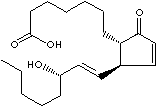PROSTAGLANDIN A1
PRODUCT IDENTIFICATION
14152-28-4

H.S. CODE
TOXICITY
9-Oxo-15S-hydroxy-prosta-10,13E-dien-1-oic acid; PGA1;
CLASSIFICATION
Anti-Infective, Antiviral
EXTRA NOTES
PHYSICAL AND CHEMICAL PROPERTIES
REFRACTIVE INDEX
Stable under ordinary conditions.
EXTERNAL LINKS & GENERAL DESCRIPTION
Drug Information Portal (U.S. National Library of Medicine) - Prostaglandin A1
PubChem Compound Summary - Prostaglandin A1
Drug Bank - Prostaglandin A1
KEGG (Kyoto Encyclopedia of Genes and Genomes) - Prostaglandin A1
http://www.ebi.ac.uk/chebi/ - Prostaglandin A1
http://www.ncbi.nlm.nih.gov/ - Prostaglandin A1
Human Metabolome Database - Prostaglandin A1
Local:
Prostaglandin is any member of a group of physiologically active compounds
derived from unsaturated 20-carbon polyunsaturated fatty acids, primarily
arachidonic acid. Prostaglandins are lipids having two long side chains and a 5
carbon ring structure. They are found in normal human semen in highest
concentrations. Their activities affect the nervous system, circulation, female
reproductive organs, and metabolism similar to local hormone functions But they
are not classified in hormones.
Prostaglandin belongs to eicosanoids, biologically active 20-carbon substances including prostaglandins, thromboxanes, prostacyclins, and leukotrienes. Eicosanoids are oxygenated hydrophobic cytokines, small proteins that are the core of communication between immune systems. Prostaglandins, thromboxanes, prostacyclins are derived via the cyclooxygenase pathway, while leukotrienes are via 5-lipoxygenase pathway. Prostaglandins are eicosanoids having a cyclopentane ring. Prostaglandins have two double bonds typically, while leukotrienes have four.
Prostaglandins act in the cells in which they are synthesized and surrounding cells, and their actions and effects vary with concentration, hormonal environment, and cell type. Prostaglandins mediate a wide range of physiological functions, such as control of blood pressure, regulation of muscle, glandular secretion, transmission of nerve impulses, and modulation of inflammation. Specific Prostaglandins designated by adding a letter on PG (the abbreviation for prostaglandin) to indicate the type of ring structure and a numerical subscript to indicate the number of double bonds. The subscript alpha or beta indicates the three-dimensional configuration of alcoholic groups attached to the ring structures. Alpha denotes a substituent below the plane of the ring, beta, above the plane.
|
|
APPEARANCE
ASSAY
98.0 % min